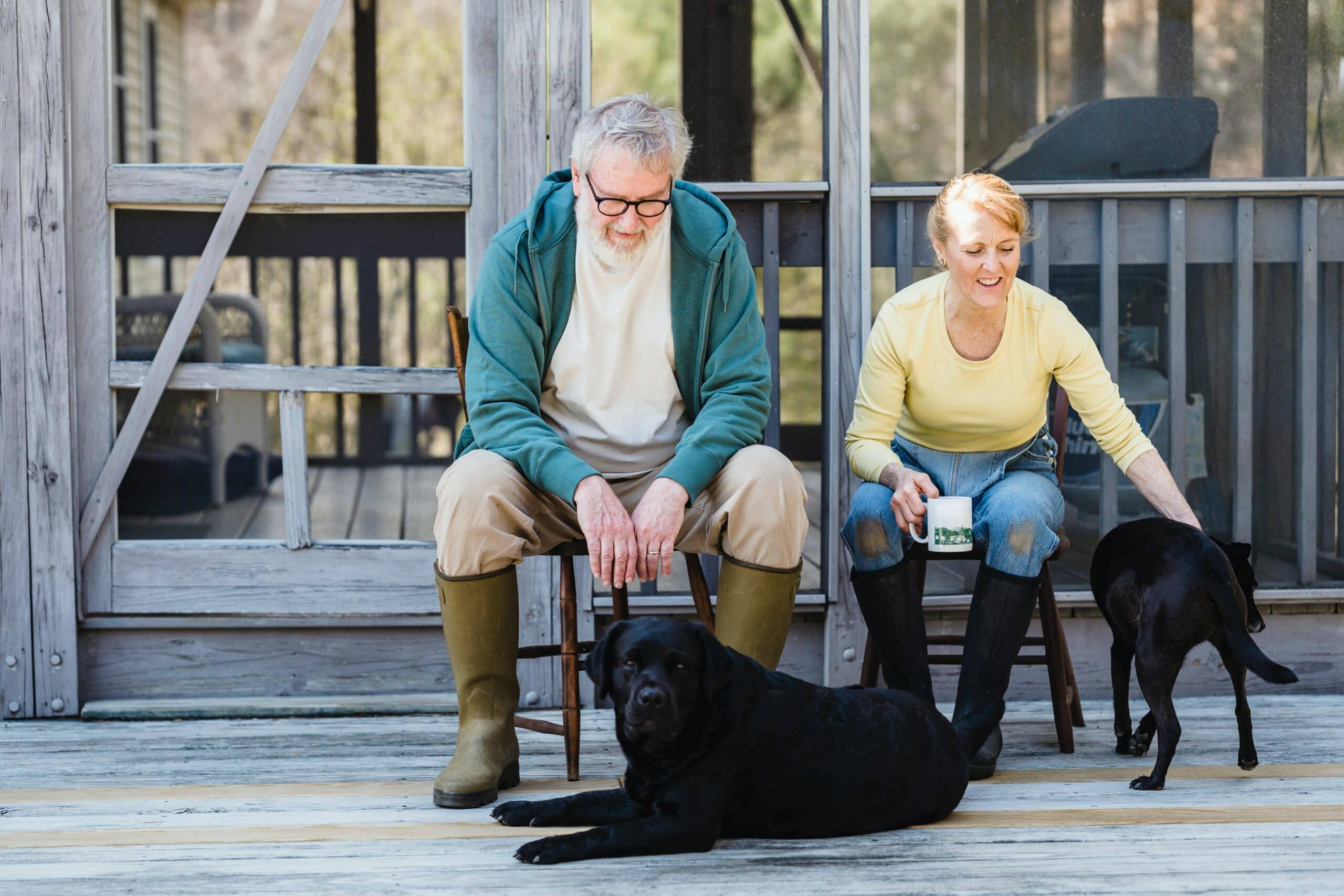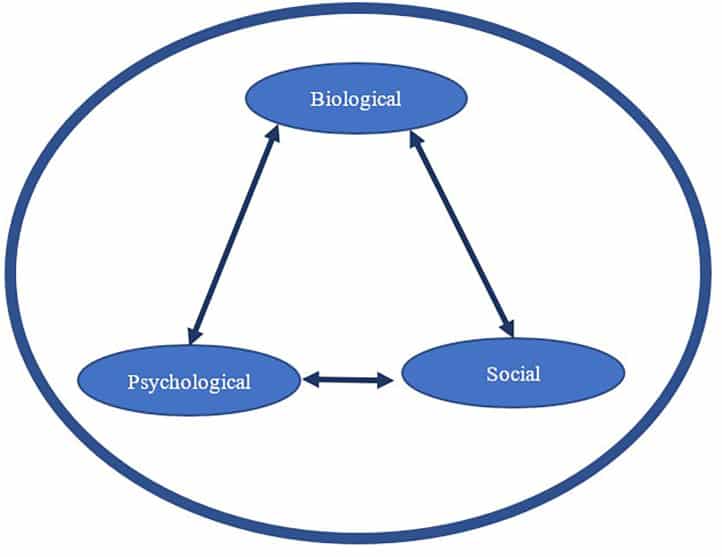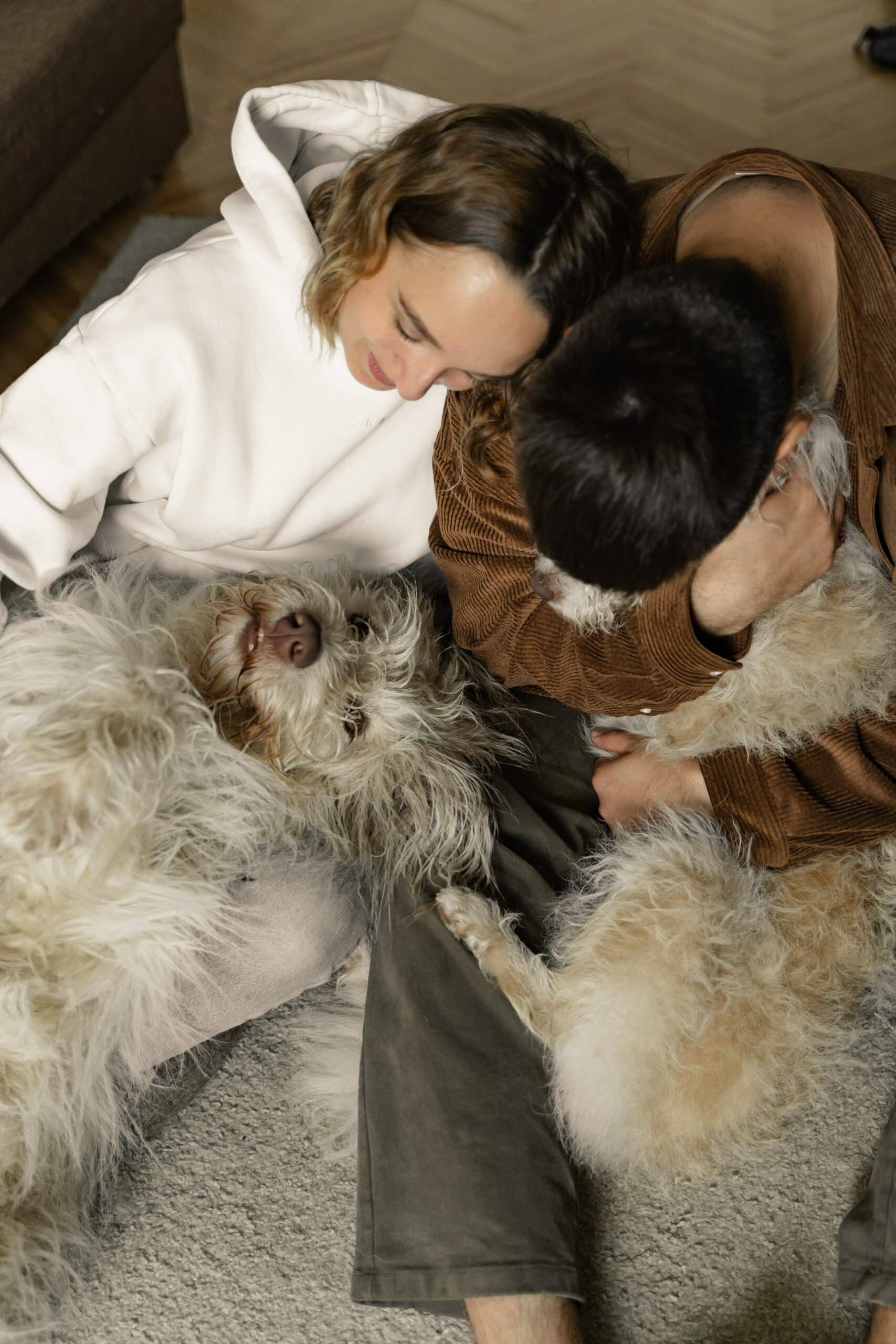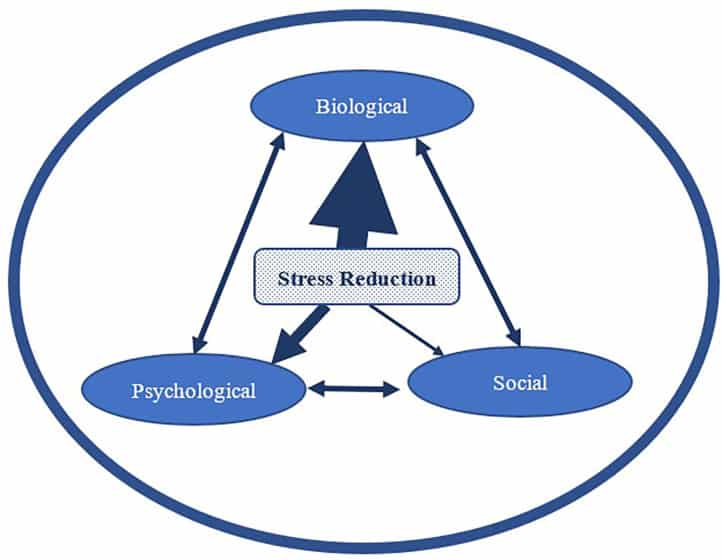
Why pets are improving human life
Why pets are improving human life
Humans have realized since the beginning of our relationship with dogs that they are helpful in a variety of tasks, for example avoiding predators and obtaining food. The most recent areas where we are involving dogs in helping us are education and therapy.
A biopsychosocial research from 2021 is giving us a lot of information about the human health and well-being benefits dogs provide us with: improving cognition, helping people with neurotypical and neurodiverse functions (Tourette Syndrome, depression, ADHD, autism, dyslexia, dysgraphia), learning disorders, mental and physical health, and disabilities.
Humans have realized since the beginning of our relationship with dogs that they are helpful in a variety of tasks, for example avoiding predators and obtaining food.
The most recent areas where we are involving dogs in helping us are education and therapy.
A biopsychosocial research from 2021 is giving us a lot of information about the human health and well-being benefits dogs provide us with: improving cognition, helping people with neurotypical and neurodiverse functions (Tourette Syndrome, depression, ADHD, autism, dyslexia, dysgraphia), learning disorders, mental and physical health, and disabilities.
Our common history with dogs
The present human-dog interaction is unquestionably unusual. Dogs have occupied a unique position in our lives as man's closest friend, with a common evolutionary history reaching thousands of years. Dogs have developed efficiency at associating with people as a result of domestication and natural selection.
Dogs, for example, are sensitive to our emotional moods as well as our social gestures, and they may communicate with us using complicated signs such as gaze alternation. Furthermore, dogs and people may create complicated attachment bonds that are similar to infant-caregiver interactions.
In the U.S.A 63 million households have a dog, and dogs are present all around the world, which means they became in time, part of our families and being treated alike. In order to live in our homes, dogs have developed the learning ability (with the help of training) to assist people with disabilities.
During World War I, in Germany and United States, dogs were trained to assist people having vision problems. Furthermore, in World War II dogs were also trained for other roles such as agility and hearing assistance.
Breed facts
Size-4 to 7,5 kg
Temperament-calm and friendly with a playful personality
Grooming-they need to be groomed frequently due to their long, double coat that mats easily
Behavior with children-they get along very well with children and babies due to their kind, friendly, and fun personality
Health Concerns-Brachycephaly-it is a malformation of the skull due to their breeding; heart disease, eye issues (caused by eye irritations and excess discharge); hair issues (they don't have fur, they have long hair with can tangle easily); ear issues( ear infections); skin sensitivity (allergies) and they also might develop a stomach sensibility due to their selective appetite
Life expectancy-10 to 16 years (the oldest recorded Shih Tzu has lived 23 years)
Our common history with dogs
The present human-dog interaction is unquestionably unusual. Dogs have occupied a unique position in our lives as man's closest friend, with a common evolutionary history reaching thousands of years. Dogs have developed efficiency at associating with people as a result of domestication and natural selection.
Dogs, for example, are sensitive to our emotional moods as well as our social gestures, and they may communicate with us using complicated signs such as gaze alternation. Furthermore, dogs and people may create complicated attachment bonds that are similar to infant-caregiver interactions.
In the U.S.A 63 million households have a dog, and dogs are present all around the world, which means they became in time, part of our families and being treated alike. In order to live in our homes, dogs have developed the learning ability (with the help of training) to assist people with disabilities.
During World War I, in Germany and United States, dogs were trained to assist people having vision problems. Furthermore, in World War II dogs were also trained for other roles such as agility and hearing assistance.
Our common history with dogs
The present human-dog interaction is unquestionably unusual. Dogs have occupied a unique position in our lives as man's closest friend, with a common evolutionary history reaching thousands of years.
Dogs have developed efficiency at associating with people as a result of domestication and natural selection.
Dogs, for example, are sensitive to our emotional moods as well as our social gestures, and they may communicate with us using complicated signs such as gaze alternation.
Furthermore, dogs and people may create complicated attachment bonds that are similar to infant-caregiver interactions.
In the U.S.A 63 million households have a dog, and dogs are present all around the world, which means they became in time, part of our families and being treated alike. In order to live in our homes, dogs have developed the learning ability (with the help of training) to assist people with disabilities.
During World War I, in Germany and United States, dogs were trained to assist people having vision problems.
Furthermore, in World War II dogs were also trained for other roles such as agility and hearing assistance.

Assistance and therapy dogs
Assistance and therapy dogs
Over the years, the functions of assistance dogs have evolved to include assisting with a wide range of impairments and ailments, including physical conditions like epilepsy and diabetes, as well as mental health issues like posttraumatic stress disorder (PTSD). At the same time, society has experienced an increase in the use of dogs in working activities such as detection, hunting, herding, and protection.
In addition to these working tasks, dogs have also assisted humans in various healing ways. With the pioneering work of Boris Levinson, Elizabeth O'Leary Corson, and Samuel Corson in the early 1960s, animal-assisted interventions (AAI) began to emerge. Levinson, a child psychologist who has been working since the 1950s, saw an unanticipated encounter between a youngster who was silent and distant during treatment and his dog, Jingles.
This encounter prompted Levinson to begin his pioneering work in laying the groundwork for AAI (animal-assisted interventions) as a therapy adjunct.
Over the years, the functions of assistance dogs have evolved to include assisting with a wide range of impairments and ailments, including physical conditions like epilepsy and diabetes, as well as mental health issues like posttraumatic stress disorder (PTSD).
At the same time, society has experienced an increase in the use of dogs in working activities such as detection, hunting, herding, and protection.
In addition to these working tasks, dogs have also assisted humans in various healing ways. With the pioneering work of Boris Levinson, Elizabeth O'Leary Corson, and Samuel Corson in the early 1960s, animal-assisted interventions (AAI) began to emerge.
Levinson, a child psychologist who has been working since the 1950s, saw an unanticipated encounter between a youngster who was silent and distant during treatment and his dog, Jingles.
This encounter prompted Levinson to begin his pioneering work in laying the groundwork for AAI (animal-assisted interventions) as a therapy adjunct.
Dogs helping psychiatric patients
Samuel Corson and Elizabeth O'Leary Corson were among the first academics to do empirical research on canine-assisted treatments in the 1970s. They, like Levinson, discovered unintentionally that some of their patients with psychiatric problems were interested in the dogs, and that their patients with psychiatric disorders spoke more freely with each other and the staff when they were in the company of the canines.
Therapy dogs have been progressively discovered to give assistance to persons with different needs in a variety of settings during the following decades.
Dogs helping psychiatric patients
Samuel Corson and Elizabeth O'Leary Corson were among the first academics to do empirical research on canine-assisted treatments in the 1970s.
They, like Levinson, discovered unintentionally that some of their patients with psychiatric problems were interested in the dogs, and that their patients with psychiatric disorders spoke more freely with each other and the staff when they were in the company of the canines.
Therapy dogs have been progressively discovered to give assistance to persons with different needs in a variety of settings during the following decades.

A biopsychosocial research
A biopsychosocial research
The biopsychosocial model has been extensively utilized for over 40 years to describe how biological, psychological, and social processes interact to affect human health and well-being.
Biological impacts include physiological changes such as blood pressure, cortisol, and heart rate; psychological influences include personality, mood, and emotions; and social influences include cultural, socioeconomic, social interactions with others, family dynamics, and associated issues.
The picture depicts the link between these three parameters in determining health status and well-being.
The biopsychosocial model has been extensively utilized for over 40 years to describe how biological, psychological, and social processes interact to affect human health and well-being.
Biological impacts include physiological changes such as blood pressure, cortisol, and heart rate; psychological influences include personality, mood, and emotions; and social influences include cultural, socioeconomic, social interactions with others, family dynamics, and associated issues.
The picture depicts the link between these three parameters in determining health status and well-being.

The biopsychosocial system is dynamic
Although the model has dominated health psychology research and theory for decades, it has recently been re-envisioned as a more dynamic system that views human health as the matter of fact of the mutual impacts of biological, psychological, and social factors that take place over individual and historical time.
For instance, if a person fractures his or her arm, the immune and muscular systems will adapt and compensate. When others give support or help, social or interpersonal changes might emerge. As a consequence of adapting to and managing the injury, psychological changes will develop. As a result, the damage is a dynamic influence that begins at one moment in time and continues forward in time, with decreasing intensity as recovery occurs.
From a biopsychosocial point of view, the nature of the human-dog relationship is dynamic and it will interact in a variety of ways with each one of the three influencing factors -biological, psychological, and social. These factors are not fixed, instead, they have an interactional effect on each other over time.
The biopsychosocial system is dynamic
Although the model has dominated health psychology research and theory for decades, it has recently been re-envisioned as a more dynamic system that views human health as the matter of fact of the mutual impacts of biological, psychological, and social factors that take place over individual and historical time.
For instance, if a person fractures his or her arm, the immune and muscular systems will adapt and compensate.
When others give support or help, social or interpersonal changes might emerge.
As a consequence of adapting to and managing the injury, psychological changes will develop.
As a result, the damage is a dynamic influence that begins at one moment in time and continues forward in time, with decreasing intensity as recovery occurs.
From a biopsychosocial point of view, the nature of the human-dog relationship is dynamic and it will interact in a variety of ways with each one of the three influencing factors -biological, psychological, and social.
These factors are not fixed, instead, they have an interactional effect on each other over time.

HAI is dynamic
The research is supporting the idea that human-animal interaction (HAI) has a dynamic nature because a person that might have different dogs during their lifetime (that will go from puppy stage to adult) will have a different interaction with the dogs (and vice-versa) during their life together.
HAI is dynamic
The research is supporting the idea that human-animal interaction (HAI) has a dynamic nature because a person that might have different dogs during their lifetime (that will go from puppy stage to adult) will have a different interaction with the dogs (and vice-versa) during their life together.

The researchers explore the benefic potential of dogs
Whereas a person's biological, psychological, and social health may influence their relationship with dogs with whom they interact, the focus of this study is on the opposite: how possessing or having contact with a dog could influence each one of the mental, biological, and social influencers of human health.
According to the biopsychosocial model, the researchers will also present pertinent studies and explore potential processes by which dogs may or may not contribute to human health and well-being.
The researchers explore the benefic potential of dogs
Whereas a person's biological, psychological, and social health may influence their relationship with dogs with whom they interact, the focus of this study is on the opposite: how possessing or having contact with a dog could influence each one of the mental, biological, and social influencers of human health.
According to the biopsychosocial model, the researchers will also present pertinent studies and explore potential processes by which dogs may or may not contribute to human health and well-being.

HAI reduces depression
There have been a lot of studies done on the effects of dog owners and dog connections on human mental health and functioning. Frequent contact with a dog, whether through ownership or long-term therapies, has been linked to favorable psychological effects over the lifetime.
Depression, particularly in older persons, is a psychological feature of importance to several HAI (human animal interaction) researchers. However, the association between companion dog ownership and depression across the lifetime remains variable and ambiguous. Nonetheless, there are cases in the literature that show the positive impact of dog ownership in depression reduction.
It has been shown that animal relationship has decreased the depression episodes which were measured by self-reports. The mechanism for depression reduction is supported by biological and social factors.
One study found that dogs were essential for elderly women suffering from loneliness. The fact that they had a dog has saved them from developing a severe depression caused by loneliness. People who are suffering from depression have more chances to own a dog in comparison with people that don't suffer from depression.
HAI reduces depression
There have been a lot of studies done on the effects of dog owners and dog connections on human mental health and functioning.
Frequent contact with a dog, whether through ownership or long-term therapies, has been linked to favorable psychological effects over the lifetime.
Depression, particularly in older persons, is a psychological feature of importance to several HAI (human animal interaction) researchers. However, the association between companion dog ownership and depression across the lifetime remains variable and ambiguous.
Nonetheless, there are cases in the literature that show the positive impact of dog ownership in depression reduction.
It has been shown that animal relationship has decreased the depression episodes which were measured by self-reports. The mechanism for depression reduction is supported by biological and social factors.
One study found that dogs were essential for elderly women suffering from loneliness. The fact that they had a dog has saved them from developing a severe depression caused by loneliness.
People who are suffering from depression have more chances to own a dog in comparison with people that don't suffer from depression.
Animals reduce anxiety
Another psychological benefit of the human-dog relationship is the decreased level of anxiety. Studies have found that a short-term interaction with a therapy pet can decrease significantly the levels of anxiety and distress.
As an example, children that were with their pet dog or a therapy dog had a lower anxiety level when they were put in a stressful situation (in comparison with when the children were with a parent, a stuffed animal, or when they were alone).
In this context, the dog might have served as a comforting presence or a distraction from the stress-creating situation.
Animal-assisted therapy is more effective for patients who have experienced trauma (due to the comforting benefits of the present animal).
The simple activities owners share with their dogs (such as walking or playing) are important, because they are the factors that might explain the increased well-being of pet owners. The well-being factor depends from one owner to another due to the difference between their marital status (if they feel lonely), their personality (if their mood can be improved by the pet), and the attachment they have to the dog.
Also, pet owners can have a better motivation for their daily activities, because they need to take care of their pet.
Animals reduce anxiety
Another psychological benefit of the human-dog relationship is the decreased level of anxiety.
Studies have found that a short-term interaction with a therapy pet can decrease significantly the levels of anxiety and distress.
As an example, children that were with their pet dog or a therapy dog had a lower anxiety level when they were put in a stressful situation (in comparison with when the children were with a parent, a stuffed animal, or when they were alone).
In this context, the dog might have served as a comforting presence or a distraction from the stress-creating situation.
Animal-assisted therapy is more effective for patients who have experienced trauma (due to the comforting benefits of the present animal).
The simple activities owners share with their dogs (such as walking or playing) are important, because they are the factors that might explain the increased well-being of pet owners.
The well-being factor depends from one owner to another due to the difference between their marital status (if they feel lonely), their personality (if their mood can be improved by the pet), and the attachment they have to the dog.
Also, pet owners can have a better motivation for their daily activities, because they need to take care of their pet.

Animals help with PTSD,ASD and ADHD
A number of studies have demonstrated that dog involvement may have special psychological advantages for those with physical limitations and chronic diseases.
Cohabiting with a professionally trained assistance dog, such as a guide, hearing, or service dog, has been linked to improved psychological and emotional functioning in people with impairments.
A recent study has also revealed that having a psychiatric service dog is connected with fewer PTSD symptoms, less sadness and anxiety, and a higher quality of life in people with mental diseases such as post-traumatic stress disorder (PTSD).
These advantages appear to be the result of a mix of the service dog's specialized training activities and elements inherent in living with a pet dog, such as having a source of affection, unconditional positive regard, social support, and companionship.
A similar study has shown the benefit of dogs for children with executive functioning and self-regulation issues, particularly autism spectrum disorder (ASD) and attention-deficit/hyperactivity disorder (ADHD).
Dogs may offer a soothing and comforting presence for certain children with ASD and may both reduce anxiety and alleviate troublesome behaviors.
Parents indicate that both companion dogs and assistance dogs can bring advantages to children with ASD (autism spectrum disorder), such as improved emotions, sleep, and conduct.
Therapy dogs have also been shown to help children with ADHD with emotional control and other elements of personal development.
Nonetheless, the outcome of dog encounters may not be favorable for all persons with ASD and ADHD; despite all the evidence of psychological advantages for some children, some may be scared of dogs or get overstimulated by them.
Animals help with PTSD,ASD and ADHD
A number of studies have demonstrated that dog involvement may have special psychological advantages for those with physical limitations and chronic diseases. Cohabiting with a professionally trained assistance dog, such as a guide, hearing, or service dog, has been linked to improved psychological and emotional functioning in people with impairments.
A recent study has also revealed that having a psychiatric service dog is connected with fewer PTSD symptoms, less sadness and anxiety, and a higher quality of life in people with mental diseases such as post-traumatic stress disorder (PTSD).
These advantages appear to be the result of a mix of the service dog's specialized training activities and elements inherent in living with a pet dog, such as having a source of affection, unconditional positive regard, social support, and companionship.
A similar study has shown the benefit of dogs for children with executive functioning and self-regulation issues, particularly autism spectrum disorder (ASD) and attention-deficit/hyperactivity disorder (ADHD).
Dogs may offer a soothing and comforting presence for certain children with ASD and may both reduce anxiety and alleviate troublesome behaviors. Parents indicate that both companion dogs and assistance dogs can bring advantages to children with ASD (autism spectrum disorder), such as improved emotions, sleep, and conduct.
Therapy dogs have also been shown to help children with ADHD with emotional control and other elements of personal development.
Nonetheless, the outcome of dog encounters may not be favorable for all persons with ASD and ADHD; despite all the evidence of psychological advantages for some children, some may be scared of dogs or get overstimulated by them.
Dogs are beneficial for children and students
Human-dog relationship is again beneficial for children from the cognitive, learning, and psychological wellness point of view.
Evidence shows that engagement with dogs bring benefit to the learning and cognition area ( children reading to a dog can improve their reading skills).
Also, connecting with a therapy dog can increase cognitive behaviors in children such as memory, classification, and obedience (in comparison with the interaction that a child has with a stuffed animal or another person).
When it comes to young adults, many universities now offer the opportunity to have a therapy dog before exams (as they are stressful situations).
The research in this area has found that students that were interacting with the pet had improved their mood and were happier, although their results for the exams didn't improve, which means that dogs may or not may improve the cognitive performances of students.
Dogs are beneficial for children and students
Human-dog relationship is again beneficial for children from the cognitive, learning, and psychological wellness point of view. Evidence shows that engagement with dogs bring benefit to the learning and cognition area ( children reading to a dog can improve their reading skills).
Also, connecting with a therapy dog can increase cognitive behaviors in children such as memory, classification, and obedience (in comparison with the interaction that a child has with a stuffed animal or another person).
When it comes to young adults, many universities now offer the opportunity to have a therapy dog before exams (as they are stressful situations).
The research in this area has found that students that were interacting with the pet had improved their mood and were happier, although their results for the exams didn't improve, which means that dogs may or not may improve the cognitive performances of students.

Biological impacts of HAI
As stated in the Psychological Influences section above, the psychological and biological impacts of HAI (human-animal interaction) are frequently intertwined, as seen by the frequency with which psychological effects are measured using biological measurements of stress, anxiety, and arousal.
A variety of research, for example, have investigated how short-term encounters with dogs might alter stress by assessing physiological indicators.
Dog contact has been shown to alter blood pressure, heart rate, and electrodermal activity as well as neurochemical indications of affiliative behavior ( beta-endorphin, prolactin, and dopamine).
Biological impacts of HAI
As stated in the Psychological Influences section above, the psychological and biological impacts of HAI (human-animal interaction) are frequently intertwined, as seen by the frequency with which psychological effects are measured using biological measurements of stress, anxiety, and arousal.
A variety of research, for example, have investigated how short-term encounters with dogs might alter stress by assessing physiological indicators. Dog contact has been shown to alter blood pressure, heart rate, and electrodermal activity as well as neurochemical indications of affiliative behavior ( beta-endorphin, prolactin, and dopamine).

Dogs are lowering cortisol levels
Quick interactions with a dog have been shown in studies to reduce both perceived stress and circulating cortisol levels. Cohabitation with a dog has also been shown to have an effect on circulating cortisol levels after awakening in children with ASD and military veterans with PTSD.
Experiments have also been conducted to see how having a dog present may affect the stress reaction and cortisol release in people who are in a stressful scenario. Studies on people have indicated that having a dog around throughout a socially stressful scenario can reduce cortisol levels compared to being alone or with a human companion.
A recent randomized controlled trial found that interacting with a therapy dog for 20 minutes twice a week for four weeks reduced cortisol (basal and diurnal measurements) in typically developing and special needs school children when compared to the same period and duration of arrival for a yoga stress relief or a classroom as the usual control group.
A child petting a dog has a multitude of benefits such as a cortisol decrease, this is why therapy dogs are used in the treatment of people with traumatic experiences, the dogs provide unconditional love, and support, raise self-esteem, and are nonjudgmental creatures.
Dogs are lowering cortisol levels
Quick interactions with a dog have been shown in studies to reduce both perceived stress and circulating cortisol levels.
Cohabitation with a dog has also been shown to have an effect on circulating cortisol levels after awakening in children with ASD and military veterans with PTSD.
Experiments have also been conducted to see how having a dog present may affect the stress reaction and cortisol release in people who are in a stressful scenario.
Studies on people have indicated that having a dog around throughout a socially stressful scenario can reduce cortisol levels compared to being alone or with a human companion.
A recent randomized controlled trial found that interacting with a therapy dog for 20 minutes twice a week for four weeks reduced cortisol (basal and diurnal measurements) in typically developing and special needs school children when compared to the same period and duration of arrival for a yoga stress relief or a classroom as the usual control group.
A child petting a dog has a multitude of benefits such as a cortisol decrease, this is why therapy dogs are used in the treatment of people with traumatic experiences, the dogs provide unconditional love, and support, raise self-esteem, and are nonjudgmental creatures.
Animals increase Oxytocin levels
The production of oxytocin is another way through which beneficial dog interaction may result in psychophysiological advantages. Oxytocin is implicated in emotion, trust, and bonding as well as buffering the stress reaction and cortisol secretion.
The oxytocin system has been proposed as a fundamental molecular mechanism in human-dog relationships.
Positive dog-owner interactions, such as caressing, petting, and conversing, have been found to enhance oxytocin levels in both dog owners and dogs, which has been linked to the strength of the owner-dog bond, as well as dog-human affiliative behaviors.
Also, pet-owning is associated with a reduced risk for cardiovascular disease (31 % risk reduction of mortality associated with these types of diseases).

Animals increase Oxytocin levels
The production of oxytocin is another way through which beneficial dog interaction may result in psychophysiological advantages. Oxytocin is implicated in emotion, trust, and bonding as well as buffering the stress reaction and cortisol secretion. The oxytocin system has been proposed as a fundamental molecular mechanism in human-dog relationships.
Positive dog-owner interactions, such as caressing, petting, and conversing, have been found to enhance oxytocin levels in both dog owners and dogs, which has been linked to the strength of the owner-dog bond, as well as dog-human affiliative behaviors.
Also, pet-owning is associated with a reduced risk for cardiovascular disease (31 % risk reduction of mortality associated with these types of diseases).
Animals ease loneliness
The social sphere is another manner in which dog friendship and contact may benefit human health and well-being.
Dogs may have an influence on social functioning by giving direct social support and a source of attachment bonding, which may contribute to better social and mental health by offering companionship.
It has been found that getting a pet dog reduces both short-term and long-term self-perceived loneliness. In periods of social isolation, like during the COVID-19 epidemic, dog ownership may act as a safety element against loneliness, particularly for people who live alone.
Dog visits to elderly people in long-term care institutions or who live alone may reduce loneliness by giving genuine companionship and social contact.
However, the research on companion dogs and loneliness is conflicting, suggesting the notion that dog ownership is a reaction to loneliness instead of a preventative measure.
Furthermore, there is a limitation of high-quality research in this field, which restricts any causal findings.
Another method that a pet dog's social support might help social functioning is by promoting social connections with others.
Observational studies, for example, have demonstrated that having a dog with you in public enhances the frequency of received social contacts and social recognitions (e.g., kind looks, smiles).
Social contacts are seen as a positive side effect by persons who walk dogs. Dogs may also contribute social capital, which is regarded as the glue that ties society together.
Wood and colleagues' study reveals that dogs can operate as human connection and interaction enhancers, with pet owners expressing greater perceptions of neighborhood hospitality and more social contacts with neighbors than non-pet owners.
Animals ease loneliness
The social sphere is another manner in which dog friendship and contact may benefit human health and well-being. Dogs may have an influence on social functioning by giving direct social support and a source of attachment bonding, which may contribute to better social and mental health by offering companionship.
It has been found that getting a pet dog reduces both short-term and long-term self-perceived loneliness. In periods of social isolation, like during the COVID-19 epidemic, dog ownership may act as a safety element against loneliness, particularly for people who live alone.
Dog visits to elderly people in long-term care institutions or who live alone may reduce loneliness by giving genuine companionship and social contact. However, the research on companion dogs and loneliness is conflicting, suggesting the notion that dog ownership is a reaction to loneliness instead of a preventative measure. Furthermore, there is a limitation of high-quality research in this field, which restricts any causal findings.
Another method that a pet dog's social support might help social functioning is by promoting social connections with others. Observational studies, for example, have demonstrated that having a dog with you in public enhances the frequency of received social contacts and social recognitions (e.g., kind looks, smiles).
Social contacts are seen as a positive side effect by persons who walk dogs. Dogs may also contribute social capital, which is regarded as the glue that ties society together.
Wood and colleagues' (Lisa Wood) study reveals that dogs can operate as human connection and interaction enhancers, with pet owners expressing greater perceptions of neighborhood hospitality and more social contacts with neighbors than non-pet owners.

Animals improve children's cognitive behavior
Pet ownership helps promote good social development in children and teenagers. Positive child–pet dog interactions have been proven to improve children's social skills, interactions, and play behavior.
Not only may children create attachment ties with dogs, but companion dogs may also enhance emotions of protection and security, which can aid in the social development of children.
Pet ownership may also assist youngsters in developing the skills necessary to create and sustain social interactions with their classmates.
Cross-sectional research, for example, discovered that children with a companion dog in the house had fewer peer difficulties and exhibit more prosocial conduct than children without a dog.
Dog involvement has also been demonstrated to improve social skills in youngsters with developmental problems.
Two randomized controlled studies for children with ADHD indicated that 12 weeks of sessions with a therapy dog, included in a curriculum meant to increase abilities and minimize behavioral difficulties, can result in better social skills, prosocial behaviors, and perceptions of social competence.
One possible reason for these advantages is that youngsters perceive nonverbal communication from dogs as less scary and simpler to comprehend than human contact.
A new eye-tracking study discovered that children with ASD give more importance to animal faces, especially dogs, than to human ones.
The presence of a dog or a cat in clinical settings may also encourage more social contact with a therapist while decreasing negative behaviors.
Furthermore, there is some data that keeping a companion dog in the home helps improve social relationships of children with ASD, particularly among speaking children, while also teaching them responsibility and sympathetic conduct.

Animals improve children's cognitive behavior
Pet ownership helps promote good social development in children and teenagers. Positive child–pet dog interactions have been proven to improve children's social skills, interactions, and play behavior. Not only may children create attachment ties with dogs, but companion dogs may also enhance emotions of protection and security, which can aid in the social development of children.
Pet ownership may also assist youngsters in developing the skills necessary to create and sustain social interactions with their classmates. Cross-sectional research, for example, discovered that children with a companion dog in the house had fewer peer difficulties and exhibit more prosocial conduct than children without a dog.
Dog involvement has also been demonstrated to improve social skills in youngsters with developmental problems. Two randomized controlled studies for children with ADHD indicated that 12 weeks of sessions with a therapy dog, included in a curriculum meant to increase abilities and minimize behavioral difficulties, can result in better social skills, prosocial behaviors, and perceptions of social competence.
One possible reason for these advantages is that youngsters perceive nonverbal communication from dogs as less scary and simpler to comprehend than human contact. A new eye-tracking study discovered that children with ASD give more importance to animal faces, especially dogs, than to human ones.
The presence of a dog or a cat in clinical settings may also encourage more social contact with a therapist while decreasing negative behaviors. Furthermore, there is some data that keeping a companion dog in the home helps improve social relationships of children with ASD, particularly among speaking children, while also teaching them responsibility and sympathetic conduct.
The mechanisms behind human-animal relationships
It is worth noting that the majority of psychological concepts are analyzed utilizing self-report ratios, such as the Beck Depression Inventory (106) or the UCLA Loneliness Scale (107), whereas a smaller group of concepts are evaluated using speed and accuracy in identifying targets (attention) or remembering information (learning and memory).
The processes that support pleasant human-dog relationships are expected to be interconnected and have a wide, but varied, impact across the three health influencers (biological, psychological, and social).
Impacts on one of the health influencers are likely to have an impact on the others, according to the biopsychosocial model. Furthermore, an underlying change mechanism may have a greater immediate influence on one world than the other two. Although this relates to the various effects outlined above, we will use stress reduction as a more particular instance of how the biopsychosocial model might be used.
The mechanisms behind human-animal relationships
It is worth noting that the majority of psychological concepts are analyzed utilizing self-report ratios, such as the Beck Depression Inventory (106) or the UCLA Loneliness Scale (107), whereas a smaller group of concepts are evaluated using speed and accuracy in identifying targets (attention) or remembering information (learning and memory).
The processes that support pleasant human-dog relationships are expected to be interconnected and have a wide, but varied, impact across the three health influencers (biological, psychological, and social).
Impacts on one of the health influencers are likely to have an impact on the others, according to the biopsychosocial model.
Furthermore, an underlying change mechanism may have a greater immediate influence on one world than the other two.
Although this relates to the various effects outlined above, we will use stress reduction as a more particular instance of how the biopsychosocial model might be used.
Animals reduce stress
Stress has been found to have an immediate and detectable effect on the biological system via endocrinological ( cortisol changes) and psychophysiological ( blood pressure changes) processes.
This similar decline in stress is likely to have an effect on the psychological system via changes in mood or affect the focus, and motivation, albeit the effect may not be directly visible or may be of lesser magnitude. This hypothesized latency or reduction in impact size is caused, at least in part, by the method these changes are normally measured and the duration for prospective effects to become observable.
Animals reduce stress
Stress has been found to have an immediate and detectable effect on the biological system via endocrinological ( cortisol changes) and psychophysiological ( blood pressure changes) processes.
This similar decline in stress is likely to have an effect on the psychological system via changes in mood or affect the focus, and motivation, albeit the effect may not be directly visible or may be of lesser magnitude.
This hypothesized latency or reduction in impact size is caused, at least in part, by the method these changes are normally measured and the duration for prospective effects to become observable.
Stress reduction schema
The process of stress reduction is utilized as one example in the shown schema for the sake of this discussion to highlight how human-dog relationships may improve people's health and well-being, as defined by the biopsychosocial model.
Stress reduction may have a greater immediate or bigger influence on the biological realm, as shown by the larger arrow while having a lesser (or maybe delayed) impact on the psychological world and an even smaller (or even more disrupted) effect on the social realm.

Based on the findings presented above, we may conclude that connecting with a dog can reduce stress in the biological realm by decreasing cortisol, heart rate, and blood pressure while increasing oxytocin.
Stress reduction can be a source of rapid increases in self-report indices of stress, mood, and anxiety, as well as longer-term benefits in general mental and life quality.
This stress reduction is also expected to have an immediate and delayed psychophysiological influence on the social sphere, as well as longer-term gains in social support, social networks, social growth, and overall social health.
Stress reduction schema
The process of stress reduction is utilized as one example in the shown schema for the sake of this discussion to highlight how human-dog relationships may improve people's health and well-being, as defined by the biopsychosocial model. Stress reduction may have a greater immediate or bigger influence on the biological realm, as shown by the larger arrow while having a lesser (or maybe delayed) impact on the psychological world and an even smaller (or even more disrupted) effect on the social realm.

Based on the findings presented above, we may conclude that connecting with a dog can reduce stress in the biological realm by decreasing cortisol, heart rate, and blood pressure while increasing oxytocin. Stress reduction can be a source of rapid increases in self-report indices of stress, mood, and anxiety, as well as longer-term benefits in general mental and life quality.
This stress reduction is also expected to have an immediate and delayed psychophysiological influence on the social sphere, as well as longer-term gains in social support, social networks, social growth, and overall social health.
Animals are essential for human's well being
As a conclusion to this series of engaging research, it is observed and demonstrated the beneficial effects the human-pet relationship has. Pets are not only good for the children's development, memory, and social behavior (including anxiety), but also for adults and the elderly who suffer from depression (caused by loneliness).
Living in our contemporary era with so much stress coming from different places, it is needed a solution to deal with it by reducing it and improving our lives.
Animals are our loyal companions, which make us happy and laugh every day.
The utilization of therapy dogs is increasing considerably ( they are used even by universities for students before exams), with all the research demonstrating that animals boost our levels of oxytocin and bring love to our universe.
And they do not hesitate to save our lives when necessary.
Animals are essential for human's well being
As a conclusion to this series of engaging research, it is observed and demonstrated the beneficial effects the human-pet relationship has.
Pets are not only good for the children's development, memory, and social behavior (including anxiety), but also for adults and the elderly who suffer from depression (caused by loneliness).
Living in our contemporary era with so much stress coming from different places, it is needed a solution to deal with it by reducing it and improving our lives.
Animals are our loyal companions, which make us happy and laugh every day.
The utilization of therapy dogs is increasing considerably ( they are used even by universities for students before exams), with all the research demonstrating that animals boost our levels of oxytocin and bring love to our universe.
And they do not hesitate to save our lives when necessary.

Until one has loved an animal, a part of one’s soul remains unawakened.
Anatole France
Until one has loved an animal, a part of one’s soul remains unawakened.
Anatole France



